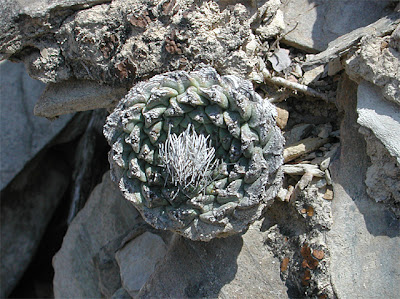The previous post featured habitat photos by Kauderwelsch who, in the meantime, has been kind enough to share more pictures at Wikimedia Commons. I’ve included a handful of his photos below.
The epidermis of this peyote cactus (Lophophora williamsii) is slightly bruised and looks like some animal nibbled on it but changed its mind after tasting the first couple of bitter bites (or maybe the bruises are just damage from the rocks scattered around the plant, but I like the “nibbling explanation” better ;-)

Peyote (Lophophora williamsii), near Monterrey, Nuevo León, México
Previously I haven’t been much into Mammillaria but seeing this magnificent picture of a flowering M. kraehenbuehlii has me wondering if I should grow some of these beautiful plants.

Flowering Mammillaria kraehenbuehlii
The next picture shows a Strombocactus disciformis growing in its typical habitat; nearly vertical, flaking limestone cliffs. It seems almost surreal that any plant is able to grow in this harsh biotope, but Strombocactus, Aztekium ritteri, and other species of cactus thrive in such conditions.
Strombocactus disciformis, near Vizarrón, Querétaro, México
The next two photos are a bit out of context (they are certainly not showing “small Mexican species”; and one is not even picturing a cactus ;-) I just fell for the beauty of the band of Cephalocereus columna-trajani standing tall against the background of towering clouds, and the sprawl of branches on that ancient looking Beaucarnea gracilis.

Cephalocereus columna-trajani,(syn. C. hoppenstedtii), near Tehuacán, Puebla, México

Adult specimen of Beaucarnea gracilis, Zapotitlán Salinas, Oaxaca, México
I have to visit México!
The photos are published under the terms of the GNU Free Documentation License. The original high resolution copies of the pictures are available here:
- Lophophora williamsii, near Monterrey, Nuevo León, México
- Flowering Mammillaria kraehenbuehlii
- Strombocactus disciformis, near Vizarrón, Querétaro, México
- Cephalocereus columna-trajani (syn. C. hoppenstedtii), near Tehuacán, Puebla, México
- Adult specimen of Beaucarnea gracilis, Zapotitlán Salinas, Oaxaca, México




















Hi Lophophora, thank for your answer. I'm searching 4-5 seeds only, for all lophophora species. If you have some seeds, are you interested to do a change? I have some seeds mix of ibrid Trichocereus, plants with big and colored floweres, if you like this genus reply me.
ReplyDeleteJack
jacopo_13@yahoo.it
Currently I only have home grown seeds of L. williamsii (they are not fuzzy about partners - the plants are self-compatible and self-pollinate readily and frequently ;-) but not in sufficient amounts to swap seeds (I'm experimenting with growing Lophophora in an unheated greenhouse and need the seeds to increase my population of plants).
ReplyDeleteEven if you are only looking for small amounts of seeds some of these seed and plant retailers might be able to help you. Jan Martin Jecminek, for example, offers a lot of different Lophophora seeds.
Have you heard of or seen White Peyote before? I have read about it online. Also it says they are of cosmic potency. Do you know where any photos of this are? One person has told me they get white with the correct conditions.
ReplyDelete-Peace
If you are referring to the "Fabled White Peyote" section of the "Native American Church" Wikipedia article, it's important to note the word "fabled". The information in this part of the NAC article is wildly unsubstantiated and should not be trusted - at least not before it is supported by serious references (which is highly unlikely to happen). M.S. Smith ventures as far as calling it crappola ;-)
ReplyDeleteWhite (achlorophyllous) seedlings are (very rarely) seen when growing plants from seed. Because of the lack of chlorophyll these plants will die unless grafted.
A seed and cactus retailer has told me the legendary cactus is true and says he has some. For some reason he cannot send a pic though.
ReplyDeleteI have gotten two white seedlings from Fricii seeds obtained from MG. They did die though. I grafted one but it still shrivled.
--
If you manage to get a picture of this cactus I would definitely like to see it (along with locality information if available). I have to admit I find this "legendary cactus" extremely dubious but one has to keep an open mind ;-)
ReplyDeleteI'm sorry to hear about your white L. fricii seedlings; I've only had one myself even though I've grown hundreds of plants from seed.